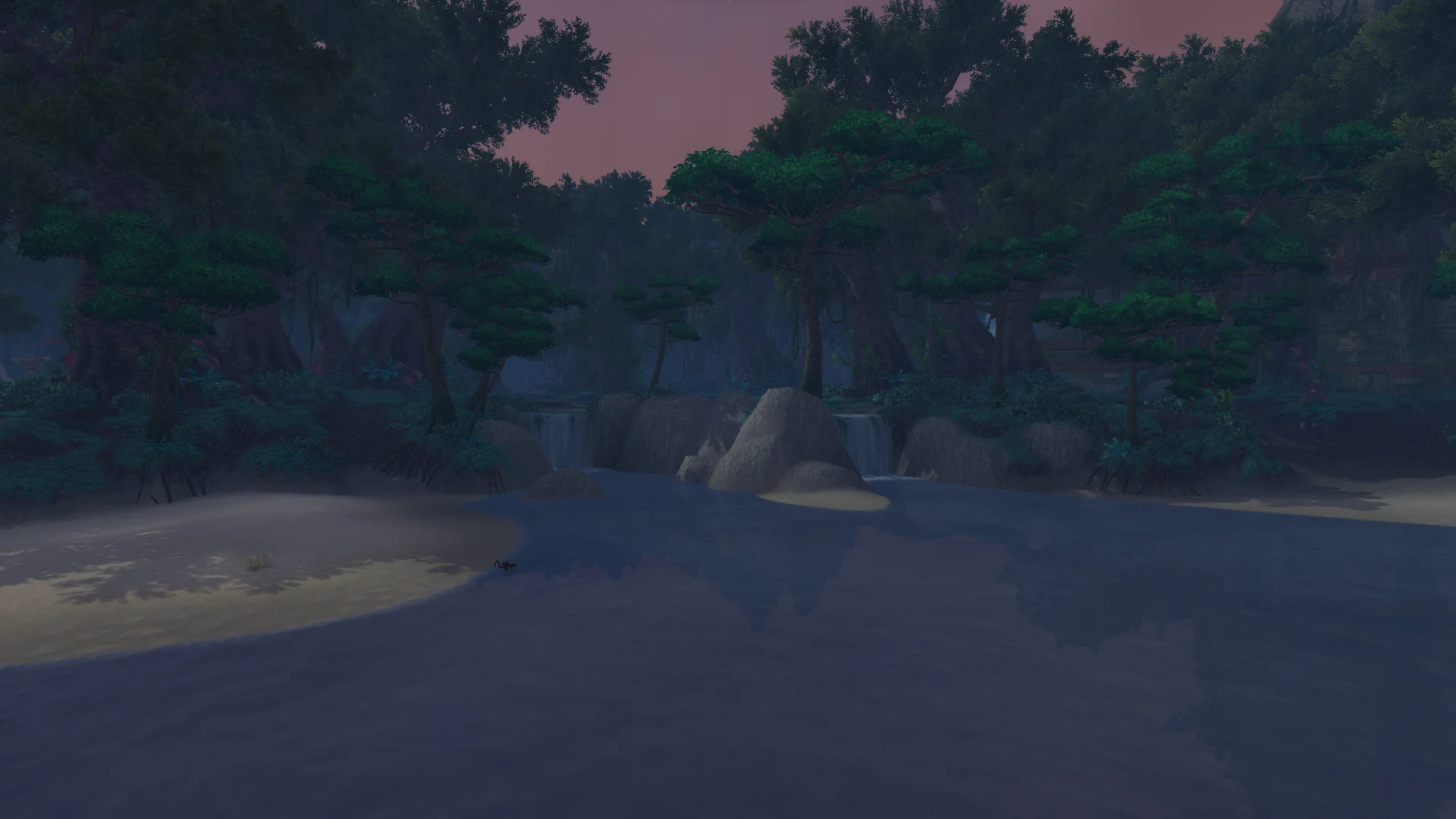
Location: Krasarang Wilds
BackKrasarang Wilds
Nestled in the heart of Pandaria, Krasarang Wilds stands as a testament to the complex and ever-evolving conflicts that have shaped the world of Azeroth. This lush and vibrant region became a focal point for the ongoing struggle between the Alliance and Horde during the Mists of Pandaria expansion. Its strategic significance, with access to the Krasarang River and the sea, turned the once-tranquil wilderness into a battleground for dominance.
Krasarang Wilds' stunning landscapes, from dense forests to serene shorelines, bore witness to fierce skirmishes, sieges, and epic battles. The conflicts within this zone mirrored the greater Alliance-Horde conflict, portraying the sacrifices made and the consequences faced by both factions in their relentless pursuit of power.
The Alliance-Horde Conflict:
Krasarang Wilds was a crucial battleground for the Alliance and Horde during the Mists of Pandaria expansion. The region's strategic importance lay in its access to the Krasarang River and the sea, making it an ideal location for resource gathering and transportation. As the Horde, under the leadership of the aggressive Garrosh Hellscream, and the Alliance, led by the resolute King Varian Wrynn, clashed for supremacy, the zone bore witness to a relentless and escalating struggle. The conflict manifested in various forms, from skirmishes and sieges to larger battles that shaped the landscape and the storyline. Players were drawn into the heart of the conflict, participating in various missions, quests, and events that showcased the escalating tensions and the toll of war on the Krasarang Wilds. The zone became a microcosm of the greater Alliance-Horde conflict, portraying the consequences and sacrifices made by both factions in their quest for dominance.
The Invasion of the Saurok:
One of the most dire threats faced in Krasarang Wilds came from the Saurok, a reptilian race known for their cunning tactics and adaptability. Warlord Bloodhilt, a Saurok leader, orchestrated a formidable invasion that posed a significant danger to both the Alliance and Horde forces. The Saurok's mastery of guerrilla warfare and their ability to strike from the shadows made them a persistent menace. Players were tasked with repelling the Saurok invasion, defending key locations, and pushing them back to reclaim territory. This conflict highlighted the diverse challenges faced by the Alliance and Horde in Krasarang Wilds, where dealing with an unpredictable and resourceful enemy was as critical as the larger factional struggle.
The Serpent's Heart:
The Serpent's Heart, an ancient Pandaren artifact, held a central position in the storyline of Krasarang Wilds. Both the Alliance and Horde recognized the artifact's potential to shift the balance of power in their favor. Its mystical properties and mysterious origins piqued the interest of leaders and strategists on both sides. The quest for the Serpent's Heart unfolded in a series of events that saw players engaged in a high-stakes battle to either protect the artifact from being seized by their enemies or to secure it for their own faction. The Serpent's Heart became a symbol of the ever-present struggle for dominance, with its fate intertwined with the broader narrative of Krasarang Wilds.
The Pandaren Resistance:
Amid the chaos and destruction brought about by the Alliance-Horde conflict, the native Pandaren population of Krasarang Wilds demonstrated remarkable resilience and determination. They formed a resistance movement, determined to protect their homeland from the ravages of war. Players often found themselves aiding the Pandaren resistance, which added depth and humanity to the storyline. The Pandaren resistance members were portrayed as heroes and protectors of their land, showcasing the strength of their community and their unwavering commitment to preserving their way of life. As players assisted the Pandaren resistance in their efforts, they were exposed to the human side of the conflict, emphasizing the collateral damage and the impact of war on innocent civilians.
The Divine Bell:
The quest for the Divine Bell, a potent Pandaren artifact, became a driving force in the Krasarang Wilds storyline. Both the Alliance and Horde believed that this artifact had the potential to change the course of the war in their favor. The search for the Divine Bell unfolded in a series of events that led players into a high-stakes confrontation. The quest for the Divine Bell resulted in dramatic confrontations, challenging moral decisions, and an exploration of the consequences of one's actions. The artifact served as a symbol of the relentless pursuit of power and the sacrifices made by both factions in their quest for supremacy. Players were forced to grapple with the ethical implications of their choices and their role in the overarching conflict.
Lorewalker Cho's Expedition:
Lorewalker Cho, a Pandaren historian and scholar, led an expedition to Krasarang Wilds to uncover its rich history and document the region's past. Players collaborated with Cho and his team to delve deeper into the zone's ancient lore, unravel mysteries, and gain insight into the events unfolding in the area. Cho's expedition added an element of historical and cultural significance to the storyline, enriching players' understanding of Krasarang Wilds. It allowed players to connect with the rich heritage of the Pandaren and provided context for the events taking place in the region, deepening their immersion in the world of Azeroth.
Sentinel Basecamp
Sentinel Basecamp, strategically positioned in Krasarang Wilds, was a pivotal stronghold for the Alliance during the conflict. It served as the central command center for Alliance forces in the region. The basecamp was fortified with watchtowers, barracks, and a network of tunnels, ensuring its defensibility. From this location, the Alliance coordinated their efforts, launched missions, and defended their interests in the wilds. It became a symbol of the Alliance's determination to secure the area and establish a foothold in Krasarang Wilds.
Downchaser Retreat
Downchaser Retreat was a crucial Horde encampment situated in Krasarang Wilds. Serving as a hub for Horde forces, it was strategically located to protect their interests in the region. The retreat buzzed with activity as Horde soldiers organized missions, launched expeditions, and stood ready to defend their territory. Its vital role was evident in the Horde's ongoing campaign in Krasarang Wilds. Downchaser Retreat became a symbol of the Horde's resilience and determination to establish their presence in the area.
Cradle of Chi-Ji
The Cradle of Chi-Ji was a place of profound significance amidst the turmoil of the Alliance-Horde conflict in Krasarang Wilds. Here, followers of Chi-Ji, the Red Crane, came together for training and spiritual guidance. Both Alliance and Horde participants engaged in friendly competition within the cradle, seeking the wisdom of Chi-Ji. It was a unique space where the desire for peace and reconciliation shone brightly, even in the midst of war. The Cradle of Chi-Ji became a symbol of hope and a testament to the enduring values of the Pandaren people.
Nayeli Lagoon
Nayeli Lagoon, a hidden gem within Krasarang Wilds, was a place of tranquility and natural beauty. With its crystal-clear waters and lush surroundings, it offered a brief respite from the chaos of the battlefield. Amidst the tension of war, Pandaren and travelers found refuge in the lagoon's serenity. It was a place where one could appreciate the enchanting wonders of nature in the wilds. Nayeli Lagoon served as a reminder of the unspoiled beauty that Krasarang Wilds had to offer, even in times of conflict.
Temple of the Red Crane
The Temple of the Red Crane was a revered Pandaren site of great spiritual importance in Krasarang Wilds. Dedicated to Chi-Ji, the Red Crane of Hope, the temple symbolized serenity and healing. It was a place where Pandaren and followers from both the Alliance and Horde sought spiritual solace. The temple's serene surroundings, including its iconic statue of Chi-Ji, added to its aura of tranquility. As the conflict played out in the wilds, the temple's spiritual significance became a focal point, with both factions acknowledging its importance in the region.
Crane Wing Refuge
Crane Wing Refuge served as a sanctuary for those devoted to the teachings of Chi-Ji, the Red Crane. Located in Krasarang Wilds, it was a place where pilgrims and followers found peace and healing. In the midst of the war, the refuge was a source of hope and rejuvenation, emphasizing the profound spiritual and cultural heritage that the Pandaren cherished. Visitors to Crane Wing Refuge could immerse themselves in the wisdom and serenity it offered, providing a counterpoint to the conflict that raged outside its borders.
Ruins of Dojan
The Ruins of Dojan held historical significance in Krasarang Wilds, as they were remnants of an ancient Pandaren civilization. These ruins were a testament to the region's rich heritage and the enduring legacy of the Pandaren people. Exploring the Ruins of Dojan allowed adventurers to uncover the mysteries of the past and connect with the land's history, even as the conflict between the Alliance and Horde raged on.
Thunder Cleft
Thunder Cleft was a natural formation in Krasarang Wilds that bore the marks of the ongoing war. Its cliffs and canyons echoed with the sounds of combat as both Alliance and Horde vied for control of this strategic location. The cleft was a site of fierce battles and shifting alliances, underscoring the fluid nature of the conflict in the wilds.
The Incursion
The Incursion was a fortified Horde outpost within Krasarang Wilds. It stood as a symbol of Horde presence in the region and their commitment to securing valuable resources. The outpost became a point of interest for adventurers as they navigated the complex web of alliances and strategies that defined the war in the wilds. The Incursion was a testament to the tenacity of the Horde in this tumultuous time.
Anglers Wharf
Anglers Wharf was a tranquil coastal community in Krasarang Wilds, known for its focus on fishing and relaxation. Despite the nearby conflict, the wharf remained an oasis of peace. Visitors could indulge in fishing, share stories, and experience a sense of camaraderie. Anglers Wharf represented the perseverance of normalcy and a reminder of life's simple pleasures, even in the midst of war.
Zhu's Watch
Zhu's Watch was a Pandaren settlement in Krasarang Wilds that remained committed to its principles of harmony and community. The watch's inhabitants strove to maintain their way of life, despite the turmoil of the Alliance-Horde conflict that surrounded them. As players interacted with the Pandaren residents and supported their efforts, they witnessed the strength of their community bonds and their determination to protect their land and traditions.
Factions in Krasarang Wilds
Krasarang Wilds was a region embroiled in conflict, and several factions played pivotal roles in the unfolding events. These factions were essential to the story and gameplay, each with its own unique objectives and alliances. Here are some of the prominent factions within Krasarang Wilds during the Mists of Pandaria expansion:
- Alliance: The Alliance, led by King Varian Wrynn, sought to establish a foothold in Krasarang Wilds. Their main base, Sentinel Basecamp, served as a hub for Alliance forces, and players aligned with the Alliance joined their efforts to secure the region.
- Horde: Under the command of Garrosh Hellscream, the Horde aimed to expand their presence in Krasarang Wilds. The Horde's stronghold, The Incursion, represented their strategic interests in the area. Players loyal to the Horde engaged in missions to further their faction's goals.
- Pandaren: The native Pandaren population in Krasarang Wilds was not just caught in the crossfire; they also organized a resistance movement to protect their homeland. Players had the opportunity to work alongside the Pandaren resistance, witnessing their unwavering determination.
- Lorewalker Cho's Expedition: Lorewalker Cho, a Pandaren historian, led an expedition to uncover the rich history of Krasarang Wilds. Players collaborated with Cho's team to delve into the zone's ancient lore and explore the cultural tapestry of the Pandaren.
Creatures in Krasarang Wilds
Krasarang Wilds is teeming with a variety of creatures, some of which played significant roles in the zone's events. From formidable foes to tranquil wildlife, the region's ecosystem is diverse. Here are some of the notable creatures you may encounter in Krasarang Wilds:
- Saurok: These cunning reptilian creatures, led by Warlord Bloodhilt, were a menacing threat to both the Alliance and Horde. Their mastery of guerrilla warfare and ambush tactics made them formidable adversaries.
- Crane Hatchlings: Graceful and majestic, the crane hatchlings were associated with the Temple of the Red Crane. These creatures symbolized tranquility and were often the focus of quests and activities.
- Tigers: Various tiger species roamed Krasarang Wilds. Some, like the Striped Minfernal, were known for their unique abilities, while others were part of the region's natural wildlife.
- Serpents: Serpentine creatures, such as the Water Serpent, inhabited the waters of Krasarang Wilds. Some were peaceful, while others posed dangers to travelers and adventurers.
- Mantid: In the southern part of the region, you might encounter the Krasarang Prowler and other mantid species. These insect-like creatures were often in conflict with the local Pandaren.
- Fish: The waters of Krasarang Wilds were teeming with various fish species, including the Redbelly Mandarin and Tiger Gourami. Fishing enthusiasts often sought these aquatic creatures.
Conclusion
Krasarang Wilds, a zone nestled along the southern coast of Pandaria, played a pivotal role in the Mists of Pandaria expansion. It served as a microcosm of the larger Alliance-Horde conflict, with the pristine landscape marred by the ravages of war. The relentless struggle between the two factions for dominance in this strategically vital region showcased the sacrifices, consequences, and challenges faced by both the Alliance and Horde. Beyond the conflict, Krasarang Wilds featured various compelling storylines, such as the Saurok invasion, the quest for the Serpent's Heart, the Pandaren resistance's determination to protect their homeland, and the pursuit of the Divine Bell. Each of these narratives added depth and complexity to the zone, highlighting the ethical and moral dilemmas faced by players as they navigated the treacherous path of war. Additionally, the presence of Lorewalker Cho and his expedition brought a cultural and historical dimension to the zone, allowing players to connect with the rich heritage of the Pandaren and enhancing their immersion in the world of Azeroth. The diverse array of factions, locations, and creatures in Krasarang Wilds contributed to a multifaceted and engaging gaming experience, making this zone an integral part of the Mists of Pandaria expansion's storytelling and gameplay. As adventurers explored the lush landscapes and unravelled the mysteries of Krasarang Wilds, they became embroiled in the larger narrative of war and sacrifice that defined the expansion, leaving an indelible mark on the history of Azeroth.
Recommended content
Feralas
Discover the untamed beauty of Feralas, a lush and diverse zone in World of Warcraft filled with unique creatures and hidden treasures.
Rogue
Master the art of stealth and subterfuge as a Rogue in World of Warcraft, and become a cunning shadow in the world of Azeroth.
Ghostlands
Explore the haunted and eerie lands of Ghostlands, a zone in World of Warcraft filled with dark history and mysteries.
Troll
Delve into the rich culture and history of the Trolls, one of the diverse races in the world of Azeroth in World of Warcraft.

